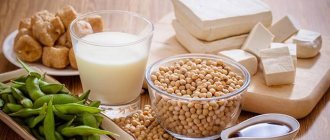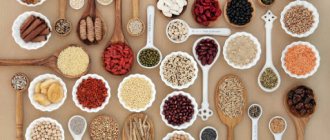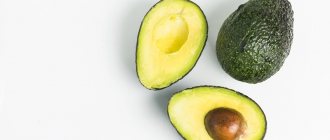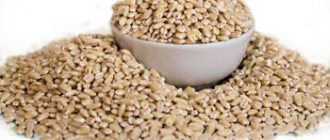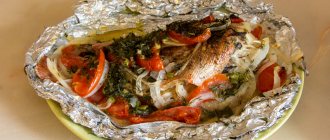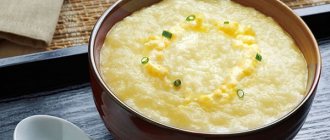Soybean (Chinese pea) is an annual herbaceous plant of the legume family, native to East Asia. Beans are considered a healthy and nutritious protein product, widely used in the food industry and in the field of traditional medicine.
Soybeans are added to feed for farm animals and included in dairy products. Processed beans are odorless and tasteless, but have the ability to absorb the flavors of other foods. This allows you to use them as a substitute in the preparation of any dishes.
Calorie content of soybeans
The caloric content of soybeans may vary. This is due to the kind of processing the product was subjected to. Beans can be boiled, fried, or stewed with other ingredients, such as meat and vegetables. There is a difference in the number of calories in boiled, fresh, and fried beans. In some cases this difference is significant.
The table provides data on the total number of calories per 100 g and the nutritional value of different types of soybeans.
| Type of soybean | Calorie content per 100 g | Energy value (BZHU) |
| Sprouted (soybean sprouts) | 122 kcal | 13.1 g protein, 6.7 g fat, 9.6 g carbohydrates |
| Fresh | 381 kcal | 34.9 g protein, 17.3 g fat, 17.5 g carbohydrates |
| Boiled (boiled) | 173 kcal | 16.6 g protein, 9 g fat, 9.9 g carbohydrates |
| Fried | 484 kcal | 48 g protein, 24 g fat, 7.4 g carbohydrates |
Fried beans have the highest calorie content: they contain almost three times more calories than boiled beans, four times more than sprouted soybeans, and a little more than 100 more than fresh beans. That is, the calorie content of soy will directly depend on the form in which it is planned to be consumed.
Products made from soy are often included in diets due to their low calorie content. However, there are also those that contain a lot of calories. To know which foods will not add weight, and which, on the contrary, will negatively affect your figure, we will provide you with a table with indicators.
| Product | Calorie content per 100 g |
| Soy milk | 54 kcal |
| Soy sauce | 53 kcal |
| Tofu cheese | 73 kcal |
| Soy flour | 291 kcal |
| Soybean grits | 384 kcal |
| Soybean paste | 197 kcal |
| Soy meat (fresh) | 296 kcal |
| Edamame (boiled green pods) | 147 kcal |
Soy products are a good replacement for milk, meat, flour, and pasta. For example, soy flour contains 291 kcal, while wheat flour contains 342, soy paste contains 197 kilocalories, and wheat paste contains 344. Consider the caloric content of fresh, boiled and fried beans.
Products containing soy
Soy is included in most food products. It is included in semi-finished products, sausages, confectionery products, milk, and baby cereals. In addition to products with low soy content, there is a range made directly from beans:
- flour - the basis of meat and noodles, produced by grinding grains;
- oil - obtained by extraction from soybeans, serves as the basis for margarine;
- milk is a product for infants, which is created by soaking and grinding beans;
- sauce – enhances the taste of dishes, it is produced by breaking down starch;
- tofu cheese - used as cottage cheese.
Recommended reading: Health Benefits of Tofu Cheese
Chemical composition
The beneficial properties of soy are associated with its chemical composition. The product has a beneficial effect on human health due to the fact that the plant contains many vitamins, minerals, amino acids and other nutrients. Each substance affects one or another system or organ, and together they become the basis for health and excellent well-being.
So, what is soy rich in?
| Group | Substances |
| Vitamins | A, E, K, C, D, PP, B vitamins (B1, B2, B5, B6, B9, B12), beta-, gamma-, delta-tocopherol, biotin, alpha-, beta-carotene, lycopene, choline |
| Macronutrients | potassium, silicon, calcium, magnesium, sulfur, phosphorus, chlorine |
| Microelements | aluminum, boron, barium, bromine, iron, germanium, vanadium, iodine, lithium, cobalt, molybdenum, manganese, copper, tin, nickel, selenium, lead, titanium, fluorine, chromium, zinc, zirconium |
| Essential amino acids | histidine, valine, isoleucine, leucine, lysine, methionine, tryptophan, theonine, phenylalanine |
| Nonessential amino acids | arginine, alanine, glycine, aspartic acid, proline, glutamic acid, serine, tyrosine, cystine |
| Unsaturated fatty acids | palmitoleic, linoleic, linolenic, oleic, stearidonic, gadoleic, arachidonic, erucic, eicosapentaenoic, clupanodonic, revonic, docosahexaenoic |
| Saturated fatty acids | lauric, stearic, myristic, pentadecanoic, palmitic, arachidic, behenic, lignoceric |
| Sterols | phytosterol, campesterol, beta-sitosterol, stigmasterol, delta-5-avenasterol |
| Carbohydrates | mono- and disaccharides, glucose, fructose, galactose, sucrose, lactose, starch, maltose, fiber, pectin |
Soybeans really contain many substances, the benefits of which for the human body are simply enormous. Vitamin, amino acid, protein and other compositions, as mentioned earlier, affect all systems. Let's look at this question in more detail:
- B vitamins. They have an active effect on the nervous and immune system. These substances improve brain function and affect metabolism and metabolic processes. It is the B vitamins that have a complex effect on the body. They charge you with energy and stimulate physical activity. A positive effect on the immune system is also due to B vitamins.
- Vitamins A and C. Fight viral and infectious diseases. These substances are natural antioxidants. Vitamin A also affects the organs of vision: relieves tension and fatigue.
- Tocopherol. It joins vitamins A and C, exhibiting its antioxidant properties, slows down cell aging, and reduces the activity of free radicals.
- Lecithin. It is easily digestible, which speeds up metabolism and, as a result, removes excess weight. The combination of lecithin and choline rids the body of bad cholesterol. That is, soybeans are a good prevention of cardiovascular diseases.
- Copper and iron. They prevent the development of anemia, take part in the functioning of the circulatory system, and bring it back to normal.
- Vitamin E and K. Have a beneficial effect on the circulatory system. These substances improve blood clotting and promote vasodilation. Vitamin E has anti-aging properties, that is, the skin becomes more elastic, beautiful and soft, and wrinkles are smoothed out. Doctors note the beneficial effects of vitamin E on reproductive function.
- Amino acids. Responsible for many functions. One of the most important is the removal of heavy metals and radionuclides from the body. Purification from such harmful substances is of great importance for people who live in regions with unfavorable environmental conditions. In addition, it is a building material for body cells.
- Alimentary fiber. Responsible for removing waste and toxins. Thanks to this, the functioning of the gastrointestinal tract is normalized. Processes in the pancreas, stomach, and intestines are stabilized. Dietary fiber solves problems such as flatulence, bloating, diarrhea, constipation.
These are the beneficial properties of soy that affect the health of both men and women. Now let’s take a closer look at the benefits of soybeans exclusively for the fair half of humanity.
As for women, soy contains natural isoflavones that have a positive effect on hormones. Thanks to these substances, all processes associated with the hormonal system are regulated and restored. There are no side effects at all. So, the benefits of soy for the female body are as follows:
- consuming soybeans reduces the risk of developing malignant cancers such as breast cancer;
- fats in the female body are not deposited thanks to lecithin, which is contained in soy, and the resulting fat cells are burned, which leads to getting rid of excess weight;
- products made from soy alleviate menopause, the painful symptoms of which are caused by a lack of estrogen. Hot flashes disappear, and the risk of developing osteoporosis decreases.
We especially focus on the benefits of sprouted soybeans. Sprouts contain a lot of protein that is valuable for health. In addition, they are rich in vitamins, minerals, enzymes and other biologically active substances. At the same time, the calorie content of sprouts is quite low. Thanks to the consumption of sprouted soybeans, the intestines are cleansed of toxins and carcinogens. Coarse fibers swell, absorb all harmful substances and rid the body of them. It is noteworthy that soybean sprouts have 30% more fiber than wheat.
Why is it useful?
The composition of the plant is unique, so moderate consumption of dishes from it has a beneficial effect on the body. Benefits of soy:
- The plant contains a lot of complete protein. It is often eaten by athletes, bodybuilders, and vegetarians. It saturates well and contains few calories.
- Antioxidant action. Soy contains many vitamins, the consumption of which has this effect.
- Protein breakdown and absorption. This action is ensured by the contained food enzymes, especially phytic acid.
- Accelerates metabolism, reduces cholesterol levels, restores cells of the nervous system. These actions are ensured due to the high content of choline and lecithin. Because of this effect, soy is often included in the diet of obese patients and patients with abnormal metabolism.
- The plant removes heavy metal salts and radionuclides from the body.
- Consumption provides prevention of stomach and duodenal ulcers.
- Soy affects the production of insulin by the pancreas and improves its functioning. It is recommended for use in diabetes mellitus.
- Positive effect on bone tissue. Beans are useful for the treatment and prevention of arthritis.
Soy contains plant substances that act on the body in the same way as estrogen. Phytoestrogens work selectively. They compensate for the lack of female sex hormone. When there is an excess of estrogen, substances suppress its excessive activity. Isoflavonoids (genistein, etc.) from plants are absolutely natural. Hormonal regulation with their help has no side effects. Why soy is beneficial for women:
- When consumed, the risk of developing malignant breast cancer tumors is reduced. Hormone-dependent formations occur when estrogen is produced excessively, and substances contained in the plant suppress this process.
- Beans are rich in lecithin. This substance prevents fat deposition, burns formed cells, and helps fight excess weight.
- Eating soy products reduces menopause symptoms caused by a lack of estrogen. Thanks to them, hot flashes will disappear and the risk of developing osteoporosis and cardiovascular diseases will decrease. Women during menopause are recommended to eat 150-200 g of soy products per day.
Sprouts contain a lot of valuable protein. They contain a full range of vitamins, biologically active substances, and enzymes necessary for the body. During germination, the concentration of useful elements increases several times. The calorie content of sprouts is very low. Their use helps cleanse the intestines of toxins and carcinogens.
It is advisable to use not canned sprouts, but those prepared with your own hands, they are healthier. To make them, soybeans need to be soaked for 6 hours. Afterwards it should be washed and covered with damp gauze. You need to make sure that the beans do not dry out; there should always be some liquid left underneath them. You need to change the water twice a day, while washing the fruits.
For men
At the end of the last century, research was conducted at Harvard, but scientists are still arguing about the benefits and harms of soy for men’s health and cannot come to a consensus. It is assumed that when consuming beans, testosterone decreases, hormonal balance and sexual functions are disrupted, and fewer sperm are produced.
It has been proven that vitamin E is directly involved in the formation of male semen, and its deficiency affects the blood vessels and nervous system. It helps prevent prostatitis, heart attack, neurosis - these diseases have become common in men. The benefits of soy for men are observed with moderate consumption. Doctors recommend daily inclusion of the product in the diet in a volume of 20 g; there is no harm from its use, and the risk of atherosclerosis and heart attack is significantly reduced.
For women
As a result of research and practical observations, the benefits of soy for women's health have been proven. During menopause, hormone therapy can be replaced by eating soybeans to maintain estrogen levels. 100 g of product contains the daily requirement of isoflavones necessary to correct hormonal levels.
It is worth finding out whether soy should be included in a child’s diet, whether the product is beneficial or harmful to the child’s body.
Beans, containing complete protein and oil, contribute to the growth of the body, activation of metabolism, and the formation of the skeleton. For children under one year of age, healthy formulas containing soy are produced. They have anti-allergenic properties and include the entire complex of essential vitamins and microelements. Recommended for those intolerant to cow's milk. The mixture should be introduced gradually over a week, after consulting with your pediatrician.
Soy products also have a beneficial effect on infections accompanied by diarrhea. The stool quickly returns to normal. Despite the medicinal properties of soy, in some cases it is worth refraining from consuming it:
- with congenital hypothyroidism;
- premature babies;
- malnutrition.
What does soy have more of – benefit or harm?
Soy products have many detractors around the world. As one of the arguments refuting the health benefits of soy, they cite the same phytoestrogens. According to some data, the use of this hormone analogue delays ovulation in women and reduces sperm count in men. However, detailed research in this area is not yet known.
Soy also contains isoflavones, which inhibit the functioning of the thyroid gland. For people suffering from endocrine diseases, soy products are harmful. Taking iodine-containing medications and seafood will help reduce the risk of iodine deficiency for healthy people. Isoflavones can cause weakness and can lead to intestinal dysfunction.
When producing vegetable oil from soybeans and seeds of other plants, trans fats are formed. The reason for this is the high content of linolenic acid. Consumption of products with such oils negatively affects the functioning of the cardiovascular system. But a cultivated soybean variety, Vistive, has been developed with a low fatty acid content, which is perfect for hydrogenating oils.
When consuming soy, harm to the body can manifest itself in the following:
• soy food causes allergies;
• oxalic acid contained in beans leads to the formation of kidney stones;
• blood pressure may decrease.
Opponents of soy are not stopped even by the centuries-old positive experience of Eastern vegetarian monks. They cross out all the beneficial properties found in soy with one simple fact. Most soybeans grown in the world today are genetically modified. The effects of genetically modified products (including soybeans) on humans, their harm and benefits have not been fully studied.
Some categories of the population should think about the food they eat and decide what soy has more of: benefit or harm?
How harmful it is: what norm can you eat?
Is soy harmful at all? We are often scared by the phytoestrogens contained in soy. They say they cause infertility. Yes, it's true, soy causes problems with procreation... in animals that consumed up to 100 mg of it per day. To obtain this dose, a person must consume more than 1,000 liters of soy milk daily to achieve similar concentrations of hormones in the blood.
Over the past 15 years, a large number of studies have been conducted, and we have data on the levels of consumption of soy products by Asians such as soy milk, soy protein, tofu, miso, natto, etc. Based on these data, it was found that the level of consumption of plant hormones is not harmful to health is 50 mg/day.
50 mg corresponds to about 30 grams of soy protein.
But if you want to get pregnant, still limit the amount of soy in your diet. A thorough 2009 meta-analysis found that consuming soy and flavonoids increases the length of your menstrual cycle, which you don't want.
You should also not feed your children soy milk substitutes. The total content of phytoestrogens in them is higher than in any other soy products! If the average Chinese person weighs 70 kg and consumes a maximum of 50 mg of flavonoids per day, i.e. less than 1 mg per kg of body weight, then infants on soy-based infant formula can consume approximately 6-9 mg. isoflavones per kg body weight per day. And this is 9 times more than adults consume. So it’s not worth the risk, although there is no data on the dangers of such feeding either.
Why are genetically modified soybeans dangerous?
Scientists have created beans with altered DNA to resist extreme weather conditions, diseases, and pests. To this end, they add or remove the corresponding genes in soybeans. The consequences of consuming such products by people have not yet been studied. Experiments were carried out on animals, which in a number of cases resulted in the detection of gastrointestinal inflammation, cancer, and immunity disorders.
Genetic modification of soybeans is a way to increase crop yields in order to provide nutrition to the growing world population. Proponents of the harmlessness of GMOs argue that 20 years of using soy products have not caused harm to humans. At least this is not reflected in WHO reports.
Indications and contraindications for use
Soybean dishes are consumed not only to diversify the diet, but also for certain indications. The beneficial effect of this product on the body helps improve the condition of certain diseases. Their list includes:
- arthrosis and arthritis;
- myocardial infarction;
- cholecystitis;
- chronic constipation;
- hypertension;
- ischemia;
- allergy to animal protein;
- atherosclerosis;
- gout
Soy is not always beneficial, so it is contraindicated for some diseases and conditions of the body. It is necessary to limit its use during pregnancy. Due to the presence of hormone-like substances in the composition, soy food can negatively affect the development of the embryo. It is also prohibited for young children whose hormonal levels have not yet been fully formed. Other contraindications to consuming soy:
- endocrine diseases;
- problems with cerebral circulation;
- urolithiasis;
- old age (due to the possible development of Alzheimer's disease).
Soy during pregnancy and breastfeeding
There is an opinion that the benefits of soy for a woman’s health during pregnancy are completely absent and the product is even harmful. The statement is incorrect, because due to the high protein content in beans, the fruit develops fully. The properties of lecithin allow the normal intrauterine formation of the baby's nervous system, iron promotes hematopoiesis.
People of the USA, Europe, and Asia use soybeans as food during pregnancy, but no complications or deviations were noticed. To obtain benefits, consumption of soybeans should be moderate: 1 - 2 cups of soy milk per day is enough.
During breastfeeding, it is necessary to take a responsible approach to introducing a new product into the diet. If after trial use (no more than one teaspoon) the baby does not experience a reaction in the form of diarrhea or rashes, then there are no prohibitions on use. Gradually the amount can be increased. During breastfeeding, the daily norm is 60 g, twice a week. With this approach, the woman and baby receive only the benefits of soy products. Consultation with a doctor is necessary.
Soy in sports nutrition
Despite the debate about the benefits and harms of soy products, the protein obtained from the plant's beans is the basis of sports nutrition. It is important for those involved in bodybuilding and fitness. Soybean isolate is used as a source of protein, supplying the cells with amino acids and giving them energy. The protein-rich nutritional supplement can be taken diluted with water or juice.
Protein is consumed an hour before or after training. This is necessary to nourish the muscles of an athlete experiencing heavy loads. Consultation with a doctor is required.
Soy for weight loss
Despite the high calorie content of the product, the soy diet is effective. This is due to the high content of lecithin in beans, which has a choleretic effect and can lower cholesterol and reduce appetite. For cellulite, soybean sprouts should be included in the diet, the benefit of which lies in their ability to renew skin cells, eliminate sagging, and make it elastic.
Due to the complete absence of fat in soy, dishes made from it are dietary. Meat, milk, cheese, butter, cottage cheese and other soy products are used to prepare them. Vegetables and cereals can be seasoned with sauce or bean paste.
Protein, which is abundant in the plant, is remarkably absorbed, strengthening muscles. But we must not forget about regular physical activity.
Due to phytoestrogens, analogues of female hormones, the soy diet is contraindicated:
- in case of thyroid dysfunction;
- during pregnancy;
- girls in adolescence.
The benefits and harms of soy lecithin
Soy lecithin contained in this product plays one of the main roles in the body. This substance is involved in the restoration of nerve tissue and brain cells. In addition, lecithin is responsible for thinking, learning, motor activity and memory. It perfectly regulates blood cholesterol levels and fat metabolism, allowing you to maintain functions at the unique level of a young body, that is, it helps fight not only diseases, but also aging.
Soy lecithin in industry is a product that belongs to the group of emulsifiers used for mixing substances with different physical and chemical properties (density, consistency, etc.). Soy lecithin is a food additive known in Russia under the code E322.
Industrial soy lecithin is found in bread, margarine and spreads, chocolate, sausages, semi-finished products (cutlets, filled pancakes), fast food products, dairy products and baby food.
Natural soy lecithin is a very healthy product!
Composition of natural soy lecithin:
- Kholin,
- Phosphodiethylcholine,
- Inositol,
- Phosphates,
- Linolenic acid,
- B vitamins.
Soy lecithin can be found in the form of a dietary supplement (biologically active food supplement), which is used for lipid metabolism disorders, heart and vascular diseases, memory disorders, pregnancy and liver diseases. If this additive is included in the composition of a cosmetic product, it combines elements of a cream or emulsion of different consistency, and also nourishes, moisturizes and smoothes the skin of the face and body.
Benefits of natural soy lecithin:
- Stimulates metabolism - destroys fats, relieves stress on liver cells, prevents obesity;
- Strengthens the heart muscle and cleanses blood vessels from cholesterol plaques - phospholipids in soy lecithin are involved in the formation of valuable amino acids that strengthen the myocardium;
- Helps the functioning of brain cells, the preservation and development of memory - during the development and growth of the child, it replenishes the composition of the brain matter, which normally consists of one third of lecithin;
- Stimulates bile secretion - by dissolving fats, lecithin makes bile liquid, preventing the formation of deposits on the walls of the bile ducts and bladder;
- Protects nerve fibers from stress by forming their myelin sheath;
- Reduces the craving for smoking - the neurotransmitter acetylcholine in soy lecithin helps brain receptors wean themselves from nicotine addiction.
Harm. Natural soy lecithin is practically harmless; the only possible harm is individual intolerance to the product. Lecithin, produced from modified soybeans (for industry), stimulates obesity, depression and memory impairment, and disruption of the endocrine system.
Composition of soy
I will not consider in detail all the vitamins and elements that make up soy, but will focus on those components of soy products that are the most “controversial” in terms of their danger/safety and require detailed consideration. These are: isoflavones (genistin), fetic acids, soy lecithin.
Isoflavones are natural components found in some plants, including soybeans. These substances belong to the group of phytoestrogens . As you know, estrogens are female sex hormones. However, contrary to popular belief, soy isoflavones are not a plant hormone. However, in their structure they do resemble one of the female sex hormones, which gives reason to assume that isoflavones, when entering the body, can have a hormonal effect similar to the effect of estrogens (although this has not been proven for sure). Moreover, some studies have shown that isoflavones can “behave” not only in a manner similar to estrogens (with a lack of estrogens), but also act as antiestrogens (with an excess of estrogens).
Genistein is a plant substance belonging to the isoflavone class. It is believed that it can delay the development of certain types of cancer, as well as heart and vascular diseases.
Phytic acid is another name for myo-inositol hexaphosphoric acid. In fact, it is a form of phosphorus in plants. Phytic acid has a fairly strong antioxidant effect and, according to some studies, is effective in treating cancer.
Lecithin literally means “egg yolk” because it was first isolated in 1845 from egg yolk. Today, the main amount of lecithin is extracted from soybeans. Soy lecithin is actively used not only in the food and chemical industries, in particular in the production of cosmetics, but also in medicine. Quite a lot of drugs and dietary supplements have been produced based on this substance to prevent liver diseases. In general, lecithin is considered a vital substance for humans, since it is found in almost all cells and tissues of the body, and, accordingly, if it is deficient, the normal functioning of all systems is impossible.
Soy products: list
Soy milk
This is a plant-based milk that is produced by squeezing soaked and boiled soybeans. It can be prepared at home without much difficulty. Up to 5% of the composition (depending on the production technology) is protein. Typically high in vitamin B12 and calcium. Quickly absorbed by the human body. Yogurts, smoothies, tofu, cocoa and coffee, such as soy milk lattes, have a delicate and mild taste. The beneficial properties of soy milk are due to the presence of vitamin E, isoflavones, lecithin and low saturated fat content.
See Also News
Rihanna has released an ultra-trend vegan leather capsule
Soy chocolate
It is a dietary analogue of regular chocolate. During production, cocoa beans are replaced with soybeans. The benefit of such chocolate is that its calorie content is much lower compared to regular sweets. For this reason, it is widely used in dietary nutrition. Soy chocolate is especially recommended for people suffering from excess weight.
Tempe
It is a fermented food product made from whole soybeans. They are softened, opened or peeled, and then boiled, but not completely. Next, a starter with a fungal culture or an acidifier is added to the boiled beans. At the end they are placed in a thin layer, and then fermented for 24 hours at 30 degrees. The finished product is very rich in protein. Tempeh is used by vegetarians. It is cut into pieces, then fried in oil, adding other ingredients. Tempeh is served in soups, with a side dish or as a separate dish.
Yuba
Otherwise called fuli, fuzhu or doupi. Yuba is the surface foam of soy milk, used in dry or raw form. This ingredient belongs to East Asian cuisine. In Russia, yuba is known as “soy asparagus,” although it has nothing to do with asparagus. Soy milk is boiled, resulting in a hard layer called yuba appearing on the surface. It contains a lot of fat. Using special equipment, the film is removed and hung to dry. They prefer to eat fuzhu fresh as a snack or dipped in sauce.
Soy meat
This is a textured product obtained by extrusion cooking of dough based on water and meal or flour. The resulting spongy product is cut into pieces and dried. The result is dry, textured flakes or goulash. The product is among those who refuse food of animal origin because it contains protein important for a healthy diet. It can be used in all recipes with meat ingredients as a substitute.
Bean curd (tofu cheese)
Tofu, which is called both curd and soy cheese, is produced by curdling milk with coagulants. Varieties of tofu differ in hardness, smell, and the presence of additional ingredients that determine its flavor and aromatic properties. Traditional tofu has been consumed in Southeast Asia for more than 2 thousand years and remains popular today.
The composition and beneficial properties of soy curd are generally similar to other products. It gives the body a lot of valuable protein, amino acids, minerals (especially calcium, sodium, iron), phytoestrogens. It is used in the preparation of desserts, soups, salads, cold and hot dishes, and smoked snacks.
Soy flour
It is made from dry seeds or meal. Contains almost no starch. Soy flour contains significantly more nutrients and protein than other types. Has binding properties. Because of this, it is good to add such flour to the dough in equal proportions with wheat or other cereals. Eggs can be omitted. Ideal for all types of lean baked goods.
Their defatted flour is produced by extrusion cooking. Soy meat is low in calories and contains a minimal amount of cholesterol. Perfect for dietary nutrition, vegetarian lifestyle. During meat production, all the nutritional properties of the beans are preserved. It contains eight essential acids, so it increases hemoglobin and improves blood quality. Rich in iron and minerals. Well absorbed by the body.
Before cooking, the meat is soaked in water, broth or broth for some time, or boiled, depending on the instructions on the package. The pieces soften and the texture becomes similar to the real thing. You can add any sauces, salt, seasonings and spices to taste. After softening, you can cook with the meat the same as with regular meat: main courses, soups, salads.
Soy sauce
Fans of Asian cuisine have long been familiar with soy sauce, which is used to prepare a huge number of dishes. Preparing natural soy sauce takes about a year. It is made from evaporated soybeans and roasted wheat grains, which then undergo an enzymatic fermentation process in special containers. After a year, the sauce is filtered and bottled.
Benefits of soy sauce:
- Improved blood circulation;
- Fight free radicals with antioxidants;
- Prevention of cardiovascular diseases;
- Increased content of amino acids;
- Minimum calorie content, no cholesterol.
Unfortunately, the desire to make a profit leads soy sauce manufacturers to adulterate their product. To speed up the fermentation process, pathogenic bacterial cultures are added to the sauce, which allows you to get something like a sauce in a month instead of a year. An even more harmful method is boiling soybeans in hydrochloric acid and quenching this solution with alkali or diluting soy concentrate with plain water.
Using adulterated sauce is dangerous due to the carcinogens it contains. Both regular sauce and sauce prepared using cheaper technology contain an excessive amount of salt, which leads to salt deposits.
Soybean oil
Soybean oil is an extremely healthy product containing a large amount of vitamins, minerals and biologically active substances. It has been used in the countries of Indochina for about 6 thousand years, and in Europe it became known only in the 20th century. Soybean oil is produced by pressing and extracting soybeans. It is refined and deodorized, giving it consumer qualities.
Soybean oil has a straw-yellow color and a light, pleasant aroma. It is used to produce lecithin - a component of food, soap, medicines, dyes; it is fried in soybean oil, added to salads, and baked goods. The calorie content of 100 g of this product is 889 kcal. It is considered a champion in terms of tocopherol and microelements content compared to olive and sunflower oil.
Beneficial properties of soybean oil:
- Vitamins and microelements help prevent cancer and cardiovascular diseases;
- Choline, organic acids improve the functioning of the liver and heart muscle, regulate cholesterol levels in the blood;
- When consuming oil, diseases of the digestive tract are prevented and metabolism is regulated;
- The number of immune disorders is reduced.
To demonstrate the beneficial properties of soybean oil, it is enough to consume it 1-2 tbsp. l. per day. In addition to internal use, soybean oil is widely used in cosmetology to nourish the skin of the hands and face and slow down its aging. The oil can smooth out wrinkles, moisturize chapped and rough skin, and slow down the aging process.
You should not use soybean oil if you are allergic to soy protein, during pregnancy, if you are at risk of migraine attacks, or if you have kidney or liver failure.
Application
Soybeans are not consumed raw. There are many traditional dishes with soy in Japanese cuisine - miso soup, tofu, soy milk, soy asparagus. Flour and oil are made from soybeans and used as an analogue of meat and dairy products.
Market Analytics
- Global cosmetics market 2021: an unprecedented test for the global cosmetics industry
- Top 10 Cosmetic Research and Development of 2021
- 2020 in the beauty industry – innovation without borders
Convenient search for beauty salons on our website
Beauty salons in Moscow Beauty salons in St. Petersburg Beauty salons in Ekaterinburg Beauty salons in Novosibirsk
Latest blog posts on our website
- Naturecream / Properties of the “Sunny” oil itself
- Naturecream / “Sugar” wrinkles - or what glycation can do
- Naturecream / Esterified oils
- Naturecream / Arnica - the magical plant of alchemists
- Naturecream / Tremella Extract - Snow Mushroom Detox for Skin
- Prostye-sovety / How to visually enlarge your lips with makeup
- Naturecream / Apricot kernel oil for face
- Naturecream / MATRIXYL3000 - the best skin elasticity stimulator
- Naturecream / SPF in Natural Oils
- Naturecream / Geranium (Pelargonium) oil for skin health and beauty
Latest forum topics on our website
- Natalya / How to properly make a gelatin mask?
- Mrs._Smith / Badly sunburned! What to do?((
- Ice / Is it necessary to combine fitness classes with a diet?
- Antonova / What can be used for hair loss?
- Radio operatorKat / Who was on a protein diet?
Other articles in this section
| Okra A herbaceous vegetable plant belonging to the mallow family. Okra is also called gumbo, okra, or lady fingers. It has been used for medicinal and culinary purposes for three and a half thousand years. Okra was very popular in Ancient Egypt. The origin of this crop has not been established, but it is assumed to be in the tropics of India or West Africa. In Russia, okra is grown in the southern regions, mainly in the Stavropol and Krasnodar Territories. |
| Plantain Plantain is a wild perennial plant. It is very unpretentious, grows in meadows, pastures, gardens, along roadsides - which is why it got its name. This is a low-growing plant with oval leaves collected in a rosette. There are more than 200 varieties of plantain around the world. All parts of the plant are edible. Plantain has been used in European medicine since the 15th-16th centuries. and was considered practically a panacea. It is even mentioned in the works of Shakespeare. |
| Pickled sweet peppers Pickling is a popular method of preserving peppers, which preserves up to 80% of vitamins and nutrients. Pickled peppers not only retain the benefits of fresh vegetables, they are also a source of beneficial bacteria and enzymes. |
| Boiled carrots At first, carrots were grown as a medicine, not a food product. The ancient Greeks and Romans considered it a strong aphrodisiac. The Roman Emperor Caligula held banquets where only carrots were served in order to arouse “wild lust” among his guests. The Dutch developed a variety of orange carrots; before that, carrots of purple, white, red, yellow, and green colors were grown. |
| Boiled broccoli Broccoli is one of the healthiest dietary foods. The birthplace of this vegetable crop is in Italy, so broccoli is often used in Mediterranean dishes. Like cauliflower, broccoli has a tree-like structure, as evidenced by its Latin name broccolo - “scion”. |
| Stevia Stevia is a South American plant of the Asteraceae family. The Stevia Rebaudiana plant is also known as sweet leaf or sugar leaf. In Latin American countries, it has been used as a sweetener for hundreds of years, but on the European continent they learned about this plant only in the 19th century. |
| Olives In Russia, black olives, the ripened fruits of the olive tree, are called olives. They are divided into two types: naturally ripened and artificially ripened. Natural olives usually contain pits. Artificially, black olives are obtained from unripe green olives through the process of oxygenation (oxidation). No dyes are used, violet-black is the natural color of ripe olives. When preserving, the stabilizer iron gluconate is added, which preserves the dark color of the olives. |
| Garlic Native to the Middle East, garlic is one of the oldest cultivated plants. It has been cultivated for 5000 years. The ancient Egyptians considered it sacred. They not only placed garlic in the tombs of the pharaohs, but also fed them to slaves to increase their strength and endurance during the construction of the pyramids. In the VI century. BC e. garlic came to India and China, where it was widely used in Chinese medicine. The healing properties of garlic are so diverse that it has gained popularity throughout the world. Garlic consists of cloves in a shell, collected into a head. It has a specific pungent taste and smell. |
| Purple Potatoes Purple potatoes are a type of sweet potato. Its homeland is the tropics of South America. It is sometimes called Japanese because purple potatoes have been an important part of the daily diet of Okinawans for centuries. |
| Boiled potatoes Potatoes are a starchy root vegetable of South American origin. The average height of a potato bush is 30-40 cm; tubers located underground are eaten. Potato tubers are considered ripe when the above-ground part of the plant dries out. |
Doctors' opinions on the benefits of soy
According to the overwhelming majority of doctors, products made from soy are harmless if there are no contraindications to them and a person does not abuse them. If these two conditions are not met, then as a result you can “earn” health problems.
- For weight loss, soy products are also very important: compared to regular ones, some of them contain more nutrients, so you will not feel a loss of strength during the diet.
- In addition, due to the presence of a high percentage of protein, athletes can undoubtedly use them for cutting in order to quickly lose excess fat and build muscle mass.
Interesting facts about soybeans
- The Chinese call soybean cereal "Great Bean".
- The process of obtaining soy sauce can take from 6 months to 2 years.
- In China, soy sauce replaces salt and preservatives.
- 100 grams of edamame = 9 grams of cholesterol-lowering fiber.
- In ancient China, soybeans were considered the food of the poor.
Sources
- https://cross.expert/zdorovoe-pitanie/produkty-pitaniya/soya.html
- https://kinopobeda.com/pitanie/soya-v-produktah-pitaniya.html
- https://kost-shirokaya.ru/pp-bez-problem/soya/
- https://sovets.net/16772-soevye-produkty.html
- https://www.ayzdorov.ru/tvtravnik_soya.php
- https://orehi-zerna.ru/soevye-produkty/
- https://happy-womens.com/soevyie-produktyi.html
- https://np-mag.ru/zdorovaya-eda/poleznye-produkty/madame-soy/
[collapse]
